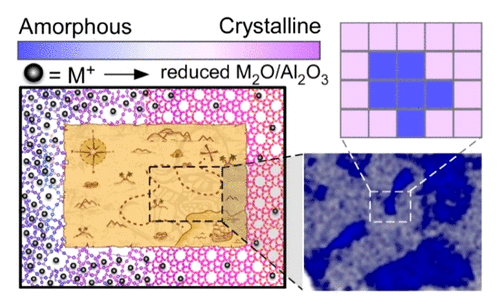当前位置:
X-MOL 学术
›
Chem. Mater.
›
论文详情
Our official English website, www.x-mol.net, welcomes your feedback! (Note: you will need to create a separate account there.)
Tracking Zeolite Crystallization by Elemental Mapping
Chemistry of Materials ( IF 8.6 ) Pub Date : 2020-04-01 , DOI: 10.1021/acs.chemmater.0c00572 Aseem Chawla 1 , Noemi Linares 2 , Rui Li 1 , Javier García-Martínez 2 , Jeffrey D. Rimer 1
Chemistry of Materials ( IF 8.6 ) Pub Date : 2020-04-01 , DOI: 10.1021/acs.chemmater.0c00572 Aseem Chawla 1 , Noemi Linares 2 , Rui Li 1 , Javier García-Martínez 2 , Jeffrey D. Rimer 1
Affiliation

|
A large number of inorganic and organic materials have been postulated to grow via nonclassical pathways involving the assembly of amorphous precursors that serve as growth units for crystallization. Elucidating the assembly, microstructure, and mechanism(s) by which precursors are involved in processes of nucleation and growth is nontrivial because of the lack of available techniques that are capable of monitoring amorphous-to-crystal transformations with sufficient spatiotemporal resolution. Here we propose an elemental mapping method employing field emission scanning electron microscopy with energy dispersive X-ray spectroscopy (FE-SEM-EDX) as a versatile tool to characterize morphological and compositional properties of precursors during the crystallization of five zeolites (MER, MFI, MOR, TON, and LTL) that are used in commercial applications that include (but are not limited to) catalysis, ion exchange, separations, drug delivery, and adsorption. Time-resolved ex situ elemental mapping images of extracted solids during several stages of zeolite crystallization reveal that a sufficient disparity in the chemical composition (e.g., alkali metal content) between amorphous precursors and crystals can be exploited for (i) tracking the early stages of zeolite crystallization, (ii) locating where it happens, and (iii) resolving residual amorphous material among crystalline domains. In this study, we also show that FE-SEM-EDX elemental mapping is a highly sensitive technique to detect the onset of nucleation, the completion of crystallization, and the existence of impurities. Given the ubiquitous presence of amorphous precursors during nonclassical crystallization, we expect that elemental mapping may prove valuable for understanding and tracking the growth of other zeolites, minerals, and related materials.
中文翻译:

通过元素映射追踪沸石结晶
据推测,大量的无机和有机材料会通过非经典途径生长,这些途径涉及装配无定形前体,这些前体充当结晶生长单元。由于缺乏可用的能够以足够的时空分辨率来监测非晶态到晶体转变的可用技术,阐明前体参与成核和生长过程的组装,微结构和机理是不平凡的。在这里,我们提出了一种采用场发射扫描电子显微镜和能量色散X射线光谱仪(FE-SEM-EDX)的元素映射方法,作为一种多功能工具来表征五种沸石(MER,MFI, MOR,TON,和LTL)用于商业应用,包括(但不限于)催化,离子交换,分离,药物递送和吸附。时间解决异地在沸石结晶的几个阶段中提取的固体的元素图谱图像显示,非晶态前体和晶体之间的化学成分(例如碱金属含量)存在足够的差异,可用于(i)跟踪沸石结晶的早期阶段,(ii )定位发生的位置,以及(iii)解决晶域中残留的无定形物质。在这项研究中,我们还表明,FE-SEM-EDX元素图谱是检测成核的开始,结晶完成和杂质存在的高度灵敏的技术。鉴于非经典结晶过程中无定形前体的普遍存在,我们希望元素图谱可能对理解和跟踪其他沸石,矿物和相关材料的生长具有重要价值。
更新日期:2020-04-23
中文翻译:

通过元素映射追踪沸石结晶
据推测,大量的无机和有机材料会通过非经典途径生长,这些途径涉及装配无定形前体,这些前体充当结晶生长单元。由于缺乏可用的能够以足够的时空分辨率来监测非晶态到晶体转变的可用技术,阐明前体参与成核和生长过程的组装,微结构和机理是不平凡的。在这里,我们提出了一种采用场发射扫描电子显微镜和能量色散X射线光谱仪(FE-SEM-EDX)的元素映射方法,作为一种多功能工具来表征五种沸石(MER,MFI, MOR,TON,和LTL)用于商业应用,包括(但不限于)催化,离子交换,分离,药物递送和吸附。时间解决异地在沸石结晶的几个阶段中提取的固体的元素图谱图像显示,非晶态前体和晶体之间的化学成分(例如碱金属含量)存在足够的差异,可用于(i)跟踪沸石结晶的早期阶段,(ii )定位发生的位置,以及(iii)解决晶域中残留的无定形物质。在这项研究中,我们还表明,FE-SEM-EDX元素图谱是检测成核的开始,结晶完成和杂质存在的高度灵敏的技术。鉴于非经典结晶过程中无定形前体的普遍存在,我们希望元素图谱可能对理解和跟踪其他沸石,矿物和相关材料的生长具有重要价值。


























 京公网安备 11010802027423号
京公网安备 11010802027423号